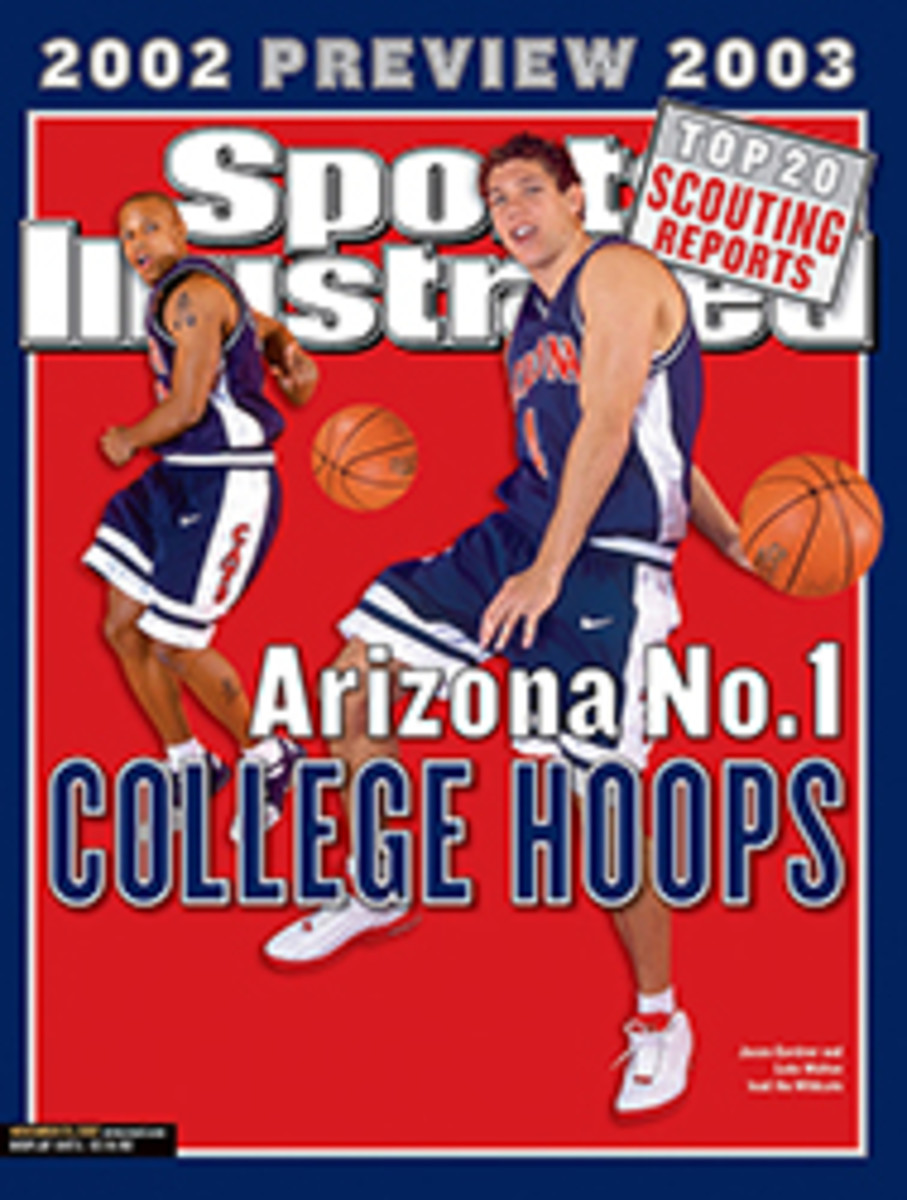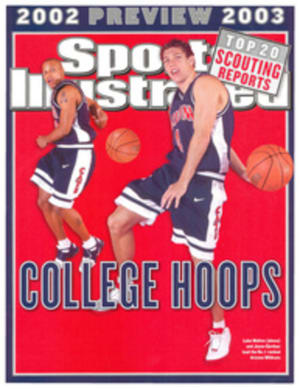
Professor Hoops When coach Charlie Coles teaches his basketball course at Miami (Ohio), it's a full-court test
PHS 331
Basketball Theory: C. Coles
Credits: 2.00
College: Education & Allied Professions
Description: Detailed study of sports fundamentals and teaching
and coaching techniques.
Charlie Coles has a theory. According to Coles, the animated,
irredeemably old-school basketball coach at Miami (Ohio), the
steady decline of defense over the years is directly connected
to the enactment of leash laws in communities around the
country. The result: a nation of chronically flat-footed youth.
"Getting chased by dogs helped me as an athlete," says Coles,
60, tongue only halfway in cheek. "Defense is anticipation, and
if you were in a neighborhood and you didn't know where the dog
was, it put some fear into you."
Professor Coles has a lot of theories, some of them specific
("Dribble right at the middle of a 1-3-1 zone. We beat Temple
here and got the best shots in the world"), some more general
("You can't coach speed, but you can coach quickness," thus
providing a remedy for the effects of the Barking Dog Theory).
For nine weeks every fall, in two-hour seminars on Tuesday and
Thursday mornings, Coles expounds on his ideas in a unique
class. Now that Bob Knight no longer presides over A362:
Coaching of Basketball, as he did at Indiana, Coles is the only
head coach at any of the nation's 150 largest schools who
teaches a course in basketball theory.
"If you're interested in coaching basketball, there's not a
better course you could take," says Matt Jameson, a senior guard
for the RedHawks who's considering such a career. (About 40% of
Coles's players take the class.) "Coach Coles has been doing this
for more than 30 years, and he's coached NBA players like Wally
Szczerbiak and Dan Majerle [at Central Michigan]. We go over
everything from scouting to assessing personnel to learning how
to build a team."
Coles--who had triple-bypass surgery in 1985 and barely survived
an on-court heart attack during the 1998 Mid-American Conference
tournament--isn't required to lead PHS 331. But he was a high
school teacher for 19 years, giving five classes a day, from math
to health, drawing to phys ed, and it got in his blood. "I've
always enjoyed this," says the man whose ultrathin mustache,
fatherly wit and penchant for telling delightfully meandering
stories make him a loopy mix of John Waters, Heathcliff Huxtable
and Al McGuire. "One of the things about coaches now, the
students hardly ever see them. They're famous, but what does a
coach do during the day other than coach his guys?"
Miami is renowned as the Cradle of Coaches--Paul Brown, Weeb
Ewbank, Woody Hayes and Ara Parseghian all played or coached in
Oxford--and the administration has offered a minor in coaching
since the 1950s. Coles graduated in '65 from Miami after twice
being named second-team all-MAC as a shooting guard. He fondly
recalls the football theory class he took as a sophomore from a
rookie head coach named Bo Schembechler. "Best teacher I've ever
had," Coles says. "He taught it so well, you ran to class every
day."
Four decades later Coles brings the same kind of energy to his
own seminars. Over nine weeks his students do a mock draft of NBA
players, observe a 6:45 a.m. off-season workout and are run
through a practice as if they were players. They learn how to
edit a scouting tape, how to address the media and (through
hilarious role-playing) how to respond to parents who are angry
about their kids' lack of playing time. With Coles's commentary,
they watch tapes of Knight's motion offense ("If you keep the
ball in the middle of the floor, the defense can't go
help-side"), Maryland's flex scheme ("I don't like it because it
crowds the floor, but it's constant movement and great if you
have versatile players") and the UCLA and Princeton high-post
offenses. ("This is fun to watch! Notice their great spacing and
how they stay high. That's how they get their back cuts.")
The students also hear rousing soliloquies on the importance of
the pivot foot. And they listen to stories. Lots of stories.
"Quick story," Coles says one day during class. "I'm working at a
high school camp in Milledgeville, Georgia, first time I ever saw
Ralph Sampson. He's 7'4", looks like he's standing on another
person. Anyway, my team's working on out-of-bounds plays. There's
not much practice time, so I say, 'O.K., run the same play, but
just call it different names.' So we do Illinois, and next time
it's Three, but it's the same play. So I start doing that with my
high school team in Saginaw, and one day I get a call from
Western Michigan University. They say, 'Hey, we want you to speak
at our clinic about your out-of-bounds plays. You run
everything!' And here I am, the worst out-of-bounds-play coach in
the country."
Everyone laughs. Coles is rolling now.
"Here's what I'm trying to say," he concludes. "It doesn't matter
much what you do if you do it really well. We developed some
calls out of it, but it was the same play. How do you practice
that? Easy. Get a bunch of fancy names. Zebra! Flash! Jordan!
That'll scare 'em away."
Coles nods over to Gerald Franklin, a junior finance major who's
been standing patiently at the dry-erase board. It's his turn to
draw up his homework assignment--an offensive play with multiple
options--in front of the class. "All right," Franklin says,
casting a sidelong glance at the professor. "We'll call this play
Charlie."
Grading in Coles's class is done on the Woody Allen curve.
("Eighty percent of success is showing up.") Yes, you're required
to turn in a neatly organized notebook at the end of the
semester, and yes, you're occasionally asked to do homework, such
as drawing up a play for a last-second shot, but your grade
depends mainly on your ability to rouse yourself two mornings a
week and trudge down Weeb Ewbank Way to Millett Hall, where class
starts at 8 a.m., no exceptions. Coles has been known to throw
out tardy students, Soup Nazi--style, and if you miss class
regularly, you will not pass.
"Good offense is like a good shoe; it will fit immediately,"
Coles says after roll call one day, welcoming his bleary-eyed,
Mountain Dew--swilling charges to his lecture. "Why are we going
to start with offense, Matt? I'm not an offensive coach."
"Because it's more exciting?"
"No. Hatcher?"
"Because you need offense to win?"
"No. Good try. Offense is the hardest thing to teach. Why? Beth?"
"Because it's hard to get people to play together?"
"Yesssss," Coles exclaims. "It's like saying, 'I'm putting
$50,000 in cash up here, now come up in an orderly fashion and
get your share.' That's what a basketball coach does."
PHS 331 is a "sprint" class, which means Coles's last seminar
takes place in early October. "It's a sad day for me," he says.
"I'll talk to them about being good leaders, about standing up
for what they think is right. If you can make a difference, make
a difference."
There's no denying that the professor heeds his own advice. "Some
of his philosophies are different from those of any coach I've
ever had," says senior Beth Roederer, a guard on Miami's women's
team. "I've learned so much about the approach I want to take
when I coach. You save all the little things you pick up from
him"--the locker room strategies, the offensive schemes, even the
relentless punctuality--"and in the end it makes a big, big
difference."
Including the Barking Dog Theory? Well, the Nobel Prize committee
may not come calling on that one, but it's proof positive: A lump
of Coles can be the purest of gems.
COLOR PHOTO: BRETT HANSBAUER COLLEGE TRY Applying his wisdom on the sideline, Coles gets an A for animation.
COLOR PHOTO: photograph by peter gregoire CHALK TALK For students in Coles's early-morning seminars, the most important requirement is to show up on time. "A coach," he says, "has to be able to get up early."
Test Your Hoops Aptitude
At SI's request, Charlie Coles devised the following quiz based
on material he covers in his class on coaching at Miami (Ohio).
Answers appear at the end.
SECTION I: TERMINOLOGY
1. A matchup zone is:
a. a sagging man-to-man defense
b. a 2--3 zone
c. a switching man-to-man defense
d. a combination zone and man-to-man defense
2. A trailer is used in the execution of:
a. defensive transition
b. a fast break
c. a team shooting drill
d. a zone press
3. A "hedge" commonly refers to:
a. a defensive strategy in which a screener's defender jumps
out and stops the ball long enough for a teammate to get
around the screen
b. an offensive play using three screeners that is also
sometimes called "the picket fence"
c. a move used by post players to get off a shot
d. a guard getting open on the perimeter
4. A player executing a "skip pass" would be passing the ball:
a. into the post
b. long, to finish a fast break
c. to the corner
d. crosscourt
5. "Ball-you-man" is:
a. a variation of the high-post offense
b. an inbounds play
c. a defensive technique for maintaining vision between your
man and the player who has the ball
d. the rule for the post man when he has the ball
SECTION II: STRATEGY AND TACTICS
6. When you pass into the post, always:
a. pass the ball high
b. pass away from the defensive man
c. lob the ball over the defender's head
d. use a bounce pass
7. When you square up off the pass or dribble to shoot the ball,
the best two methods to use would be the 1--2 (inside foot)
square-up or the:
a. bunny hop
b. stutter stop
c. jump stop
d. reverse pivot
8. For proper spacing on offense, players should be at least:
a. 4 to 6 feet apart
b. 12 to 15 feet apart
c. 16 to 18 feet apart
d. 18 to 20 feet apart
9. If an offensive player is denied the ball, he should:
a. space the floor
b. cut to the basket
c. get rebounding position
d. run to the ball
10. The best way to attack a 2--3 zone defense is to:
a. move the ball around the perimeter
b. shoot the ball quickly
c. get the ball to the mid-post area
d. rely on your best shooter
SECTION III: TRUE OR FALSE
11. All traditional zones look the same from the corner.
12. Penetrating and pitching is a great way to create three-point
opportunities.
13. The "run and jump" is a strategy to get offensive rebounds.
14. A shot hitting the side of the backboard is out-of-bounds.
15. The best type of backdoor pass is the bounce pass.
SECTION IV: HISTORY
Match the coach or player with the innovation he popularized:
16. Dean Smith a. one-hand shot
17. John Wooden b. motion offense
18. Hank Luisetti c. zone press
19. Bob Knight d. matchup zone
20. John Chaney e. four corners
HOW DID YOU SCORE?
0--5 correct: NIT bid
6--10 correct: NCAA tournament first round
11--15 correct: Sweet 16
16--19 correct: Elite Eight
20 correct: Final Four
ANSWER KEY
1. d; 2. b; 3. a; 4. d; 5. c; 6. b; 7. c; 8. b; 9. b; 10. c; 11.
True; 12. True; 13. False; 14. False; 15. True; 16. e; 17. c; 18.
a; 19. b; 20. d

